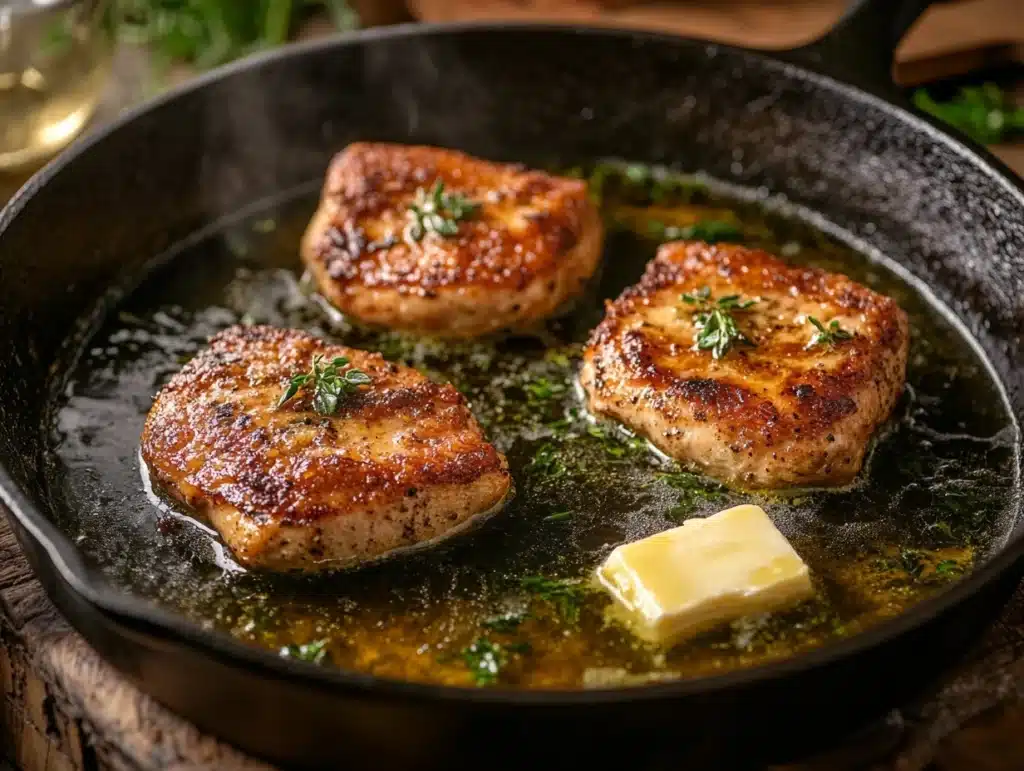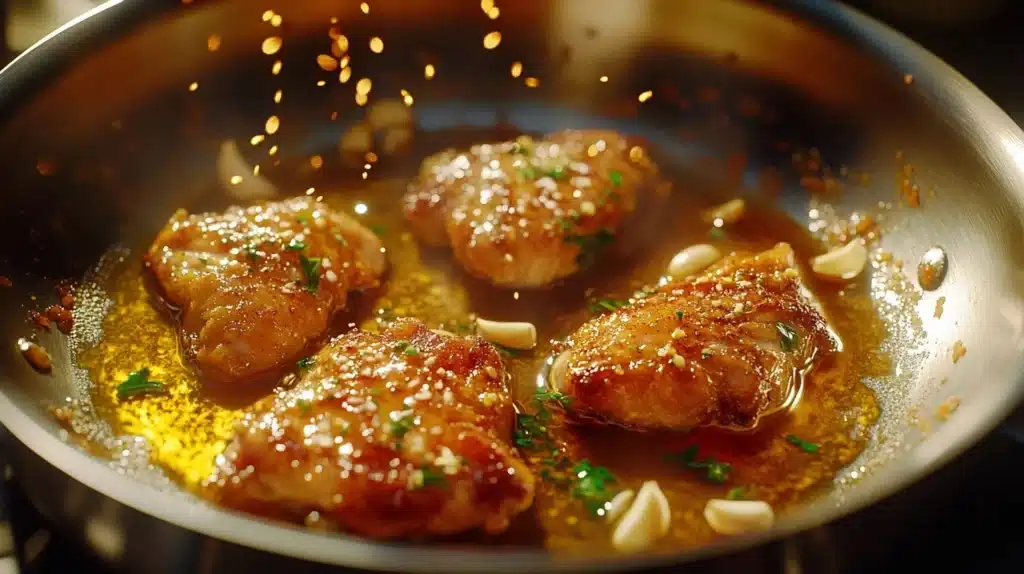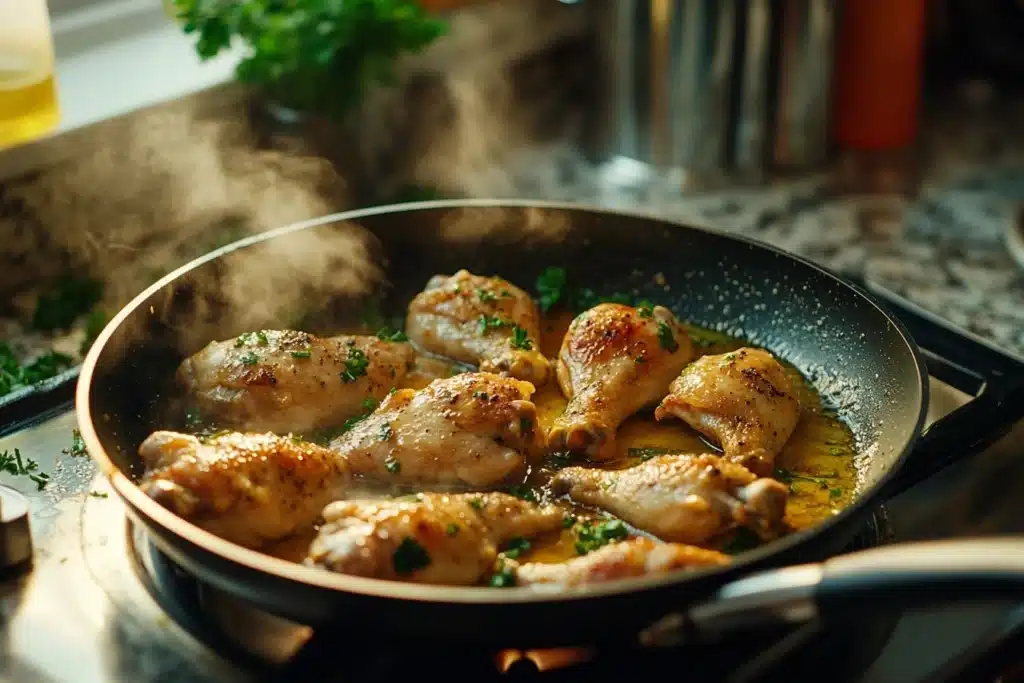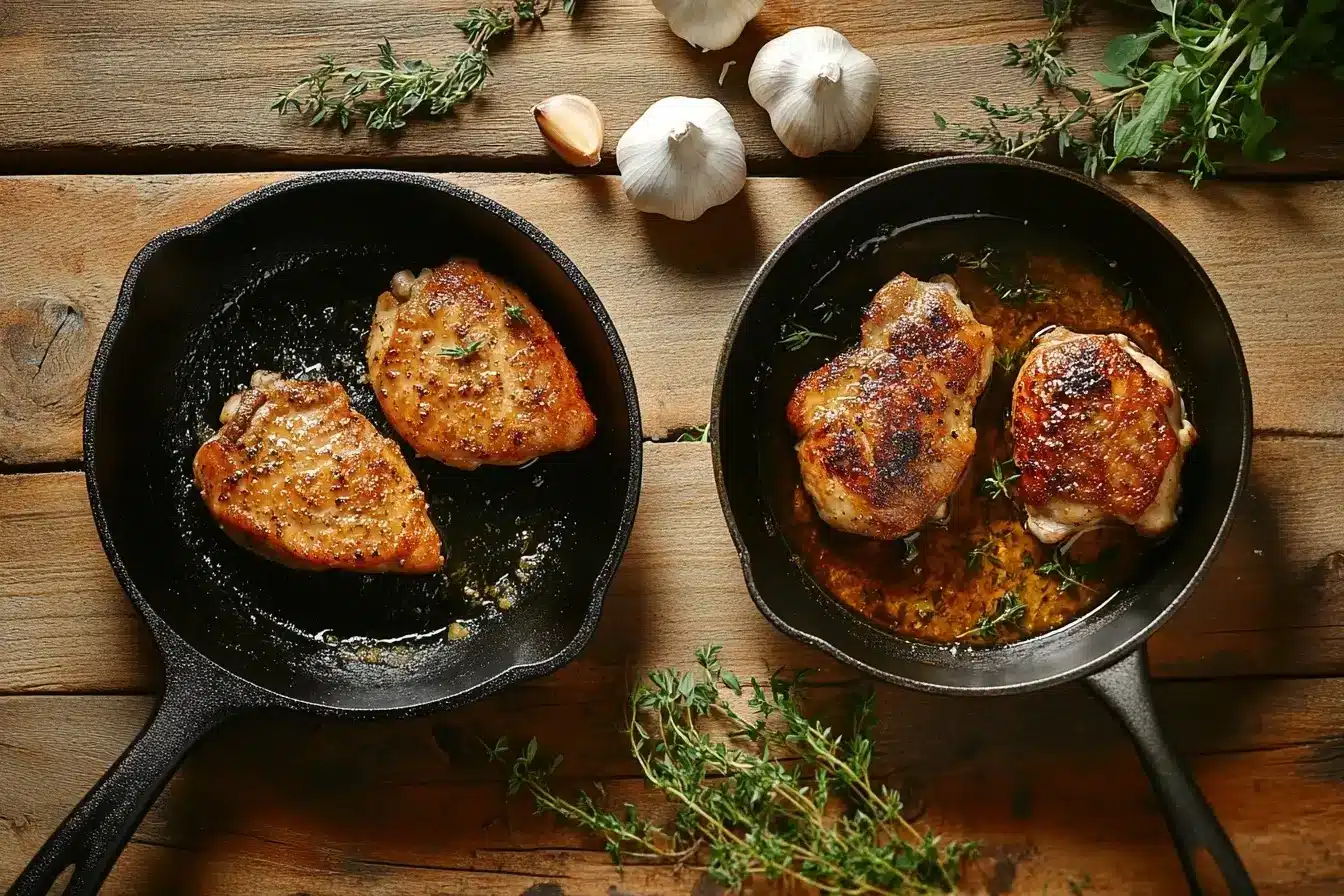Choosing between butter and oil for pan-frying chicken might seem like a small detail, but it can make all the difference in taste, texture, and even health. This article dives into the specifics—breaking down the science, flavor, cooking techniques, and expert insights to help you decide the best option for your kitchen. From buttery richness to the reliability of oil’s high smoke point, there’s plenty to learn. Let’s get started.
If you’re looking for a step-by-step guide to mastering the art of pan-frying chicken and achieving crispy perfection every time, check out The Ultimate Guide to Pan-Fried Chicken. This resource dives deeper into tips and techniques for perfecting your pan-frying skills.
Is It Better to Pan Fry Chicken in Butter or Oil?
The Importance of Choosing the Right Fat
Picking between butter and oil is more than a flavor decision—it impacts the way your chicken cooks. The type of fat determines the texture, crispness, and aroma of your dish. Butter lends a creamy, savory flavor, while oils like canola or peanut bring stability and a neutral base.
What Happens When You Pan Fry Chicken?
Pan-frying is a dry heat cooking method where chicken is cooked with a small amount of fat, enough to coat the pan. As the chicken touches the hot fat, it sears, locking in juices while forming a crispy, golden crust. The choice of fat influences how well this process works.
Butter’s Rich Flavor in Pan Frying
Butter contains milk solids that caramelize as it cooks, giving chicken a golden color and deep, nutty flavor. However, these same milk solids can burn at higher temperatures, which means butter needs careful attention during frying.
Oil’s Dependability and Versatility
With higher smoke points, oils like canola or peanut can handle more heat. They are great for creating a uniform crust on chicken without the risk of burning. Some oils, such as olive oil, add subtle earthy flavors, while neutral options let the chicken’s natural taste shine.
When Should You Use Butter or Oil?
The answer depends on your recipe. For example, dishes that need slow, controlled frying may benefit from butter. If you’re aiming for a crispy, high-temperature sear, oil may be the better bet. To maximize flavor without compromising heat tolerance, many chefs combine both.
The Science of Smoke Points
What Are Smoke Points and Why Do They Matter?
The smoke point of a fat is the temperature at which it starts to break down and produce visible smoke. Beyond the smoke, this breakdown releases free radicals and bitter compounds that can ruin your food’s flavor and harm its nutritional value. So, understanding smoke points is essential to maintain the integrity of your dish.
In pan-frying, the fat you use must withstand the heat needed to sear your chicken without burning. This ensures your chicken cooks evenly and remains flavorful.
The Smoke Point of Butter
Butter has a relatively low smoke point, approximately 350°F (177°C). This is due to the milk solids in butter, which begin to scorch at high temperatures. While butter is perfect for low to medium heat cooking, it can burn quickly if the pan gets too hot. However, clarified butter, also known as ghee, has these solids removed, raising its smoke point to about 450°F (232°C).
The Smoke Points of Common Cooking Oils
Oils typically have higher smoke points, making them better suited for high-heat cooking. Here are a few examples:
- Canola Oil: With a smoke point of 400°F (204°C), it’s a versatile and neutral choice.
- Peanut Oil: With its smoke point at 450°F (232°C), it’s ideal for frying chicken at higher temperatures without burning.
- Olive Oil: While extra virgin olive oil has a lower smoke point of around 375°F (191°C), refined versions can reach up to 465°F (240°C).
Why Smoke Points Influence Your Choice
Cooking with fats that exceed their smoke points doesn’t just risk ruining your dish; it can also fill your kitchen with an unpleasant odor and smoke. For best results, match your choice of fat with the heat level required for your recipe.
Flavor Imparted by Butter
Butter’s Role in Flavorful Pan-Frying
Butter doesn’t just cook your chicken—it transforms it. When you pan-fry chicken in butter, the fat melts into the meat, creating a rich and creamy taste that’s hard to replicate. The unique flavor profile of butter comes from its milk solids, which caramelize during cooking, adding a subtle nuttiness to your dish.
The Power of Caramelization
As butter heats, its milk solids and water content evaporate, leaving behind pure fat that sears chicken to a golden brown perfection. This caramelization infuses the meat with layers of depth and richness that pair beautifully with herbs, garlic, or lemon zest. Whether you’re cooking chicken breasts or thighs, butter enhances their natural sweetness.
Perfect Dishes for Butter-Based Frying
Some recipes truly shine with butter. Classic comfort foods like chicken piccata or herb-roasted chicken rely on butter’s luxurious flavor to elevate the dish. Additionally, it’s perfect for dishes where the fat becomes part of the sauce, blending seamlessly with other ingredients.
Considerations When Cooking with Butter
Despite its deliciousness, butter does have limitations. Its low smoke point means it can scorch quickly, turning bitter if you’re not careful. To avoid this, keep the heat on medium and monitor the pan closely. Alternatively, consider mixing butter with oil for added temperature stability without sacrificing flavor.
Flavor Imparted by Oil in Pan-Fried Chicken
Why Neutral Oils Are Perfect for Pan Frying Chicken
Neutral oils, such as canola oil or vegetable oil, are ideal for frying chicken in butter or oil. These options have mild or no flavor, allowing the chicken’s natural taste and any added seasonings to take center stage. Recipes that rely on spice rubs or marinades benefit from this subtlety, as the oil doesn’t compete with other flavors.
Flavored Oils: Adding a Subtle Twist
While many oils are neutral, others bring distinct flavor notes to your dish:
- Olive Oil: A touch of mild fruitiness enhances recipes like Mediterranean chicken.
- Peanut Oil: Its slight nuttiness works well with Asian-inspired recipes.
For instance, pairing garlic and rosemary-marinated chicken with olive oil can create a harmony of earthy and herbaceous flavors. Similarly, peanut oil elevates stir-fried chicken with its warm, nutty profile.
When High-Heat Cooking Demands Oil
One of the main advantages of cooking chicken with oil is its ability to withstand high heat. With a higher smoke point than butter, oil is essential for dishes that require consistent searing. This makes it the best choice for achieving a perfectly crispy crust in recipes like fried chicken or breaded cutlets.
Cooking with oil reduces the risk of burned fat, ensuring a clean, flavorful finish without bitterness. This reliability is particularly useful for novice cooks who might struggle to manage butter’s delicate temperature needs.
Choosing the Best Oil for Your Chicken Recipes
Your choice of oil should complement the dish you’re making:
- For Mediterranean-inspired recipes, olive oil is a classic option.
- For high-heat frying, canola oil or peanut oil are excellent due to their higher smoke points.
- For dishes needing a neutral foundation, vegetable oil lets other ingredients shine.
Ultimately, oils provide a dependable and versatile option that enhances your chicken without overshadowing its flavor or seasoning. Whether it’s crispy, golden fried chicken or a delicate herb-infused marinade, oil is an indispensable tool in your kitchen.
Nutritional Differences Between Butter and Oil
Understanding the Nutritional Profiles
When it comes to nutrition, both butter and oil bring different strengths to the table. The key lies in the type of fats they contain, which can influence not only the flavor but also the healthiness of your meal.
Butter’s Saturated Fats
Butter is rich in saturated fats, which have been linked to an increase in LDL (bad cholesterol) levels. This has potential implications for heart health, particularly if consumed in excess. However, butter also contains fat-soluble vitamins like A, D, E, and K, as well as a small amount of butyrate, a compound that supports gut health.
Oils and Unsaturated Fats
In contrast, oils such as canola and olive oil are high in unsaturated fats, which are known to improve HDL (good cholesterol) levels. These healthier fats can play a role in supporting heart health and reducing inflammation. To learn more about the benefits of unsaturated fats, check out this article on Healthline.
Nutritional Comparison Table
| Nutrient | Butter (1 Tbsp) | Olive Oil (1 Tbsp) | Canola Oil (1 Tbsp) | Peanut Oil (1 Tbsp) |
|---|---|---|---|---|
| Calories | 102 | 119 | 124 | 119 |
| Total Fat (g) | 11.5 | 13.5 | 14 | 14 |
| Saturated Fat (g) | 7 | 2 | 1 | 2 |
| Unsaturated Fat (g) | 4.5 | 11.5 | 13 | 12 |
| Cholesterol (mg) | 31 | 0 | 0 | 0 |
| Vitamin E (% DV) | 2 | 10 | 16 | 20 |
Balancing Health and Taste
While butter provides richness and depth, its higher saturated fat content means it’s best enjoyed in moderation. Oils, particularly those rich in unsaturated fats, are a better option for heart health, but they may lack the indulgent flavor of butter. Striking a balance between the two—both in your cooking and diet—is key.
Achieving the Perfect Sear with Butter
Why Butter Burns Easily
One of butter’s main drawbacks in pan-frying is its tendency to burn due to its low smoke point and the presence of milk solids. However, with the right techniques, you can avoid this issue and still enjoy its rich flavor.
Techniques to Prevent Butter from Burning
- Clarify Your Butter: By removing the milk solids, clarified butter (or ghee) becomes more heat-resistant, raising its smoke point to about 450°F (232°C). This allows you to achieve a perfect sear without risking bitter, burnt flavors.
- Combine with Oil: Mixing butter with a neutral oil like canola or peanut oil increases its heat tolerance while retaining its distinct taste. A 50-50 ratio often works well.
- Control the Heat: Keep your stovetop at medium or medium-high heat when using butter to prevent scorching.
How to Sear Chicken in Butter
- Preheat your skillet over medium heat and add a knob of butter. Watch for it to foam and then settle into a golden liquid.
- Place the chicken in the pan, ensuring it’s patted dry for even browning.
- Allow the chicken to cook undisturbed for a few minutes to develop a crisp, golden crust. Flip and repeat on the other side.
Using these methods, butter can deliver a caramelized, flavorful crust that’s worth the extra care.

Achieving the Perfect Sear with Oil
Why Oil Excels at High Heat Cooking
Unlike butter, oils like canola and peanut handle high heat with ease, thanks to their higher smoke points. This makes them excellent for achieving a consistent sear, especially for cuts that require a quick, high-temperature cook.
Steps for Searing Chicken in Oil
- Choose a heavy-bottomed skillet to retain and distribute heat evenly. Preheat it over medium-high heat.
- Add a tablespoon of oil, swirling to coat the pan. Wait until the oil shimmers—this indicates it’s hot enough for searing.
- Place the chicken in the pan without overcrowding it. Let it cook undisturbed to form a crust. Flip and cook until the internal temperature reaches 165°F (74°C).
Tips for a Crispy Exterior
- Don’t Move the Chicken Too Soon: Letting it rest undisturbed ensures that the crust forms properly.
- Use the Right Oil: Opt for oils with neutral flavors like canola, or go for peanut oil if you want a slightly nutty note.
- Adjust Heat as Needed: Avoid overheating the oil, as this can lead to uneven cooking or burnt spots.
Both butter and oil can produce a delectable sear, but your choice depends on the flavor profile and technique you prefer.

The Best of Both Worlds: Using Butter and Oil Together for Pan-Frying Chicken
Why Combine Butter and Oil for Cooking Chicken?
When asking, is it better to pan fry chicken in butter or oil, why not use both? Combining these fats brings out the best of both worlds—the creamy richness of butter and the high-heat reliability of oil. This method enhances the overall taste while ensuring a perfectly cooked piece of chicken, eliminating the risk of burning the fat during cooking.
Butter alone can scorch when exposed to high temperatures, leading to compromised flavor and texture. However, mixing butter with oil creates a stable cooking environment that solves this problem. This approach answers the common query, is it better to pan fry chicken in butter or oil, with a balanced and flavorful solution. The result? Crispy, golden chicken with a tender and juicy interior.

Flavor Meets Functionality in Pan-Frying
The milk solids in butter contribute to its distinct and indulgent taste, but these same solids are prone to burning quickly. By adding oil, you raise the mixture’s smoke point, stabilizing it for higher-temperature cooking. Neutral oils like canola or peanut oil work especially well, as they let butter’s unique flavor shine through without overpowering it. This method ensures you get the perfect answer to whether it’s better to pan fry chicken in butter or oil.
The Ideal Butter-to-Oil Ratio
For optimal results when deciding is it better to pan fry chicken in butter or oil, a 2:1 ratio works best—two parts oil to one part butter. For instance, combine 2 tablespoons of oil with 1 tablespoon of butter. This ratio gives you the buttery flavor you crave while allowing the oil to maintain a stable heat for cooking. It’s a foolproof way to achieve a crispy crust and flavorful chicken in any recipe.
By blending these two fats, you not only eliminate the need to choose between them but also address the long-debated question: is it better to pan fry chicken in butter or oil? Furthermore, this technique guarantees that your chicken will be flavorful and perfectly cooked every time. As a result, the combination of butter and oil creates a harmonious balance that elevates your dish, making it an absolute delight for your taste buds. Additionally, it provides consistency and ease, ensuring you achieve exceptional results with minimal effort.
Step-by-Step Technique for Combining Butter and Oil
- Preheat Your Pan: Begin with medium heat to avoid overheating the butter prematurely.
- Add the Oil First: Heat the oil until it shimmers—this indicates it’s hot enough to begin cooking.
- Incorporate the Butter: Add the butter, letting it melt and foam gently. The oil slows the butter’s browning, giving you more control.
- Cook the Chicken: Place your chicken in the pan and fry as usual, flipping when golden and crisp.
Perfect Recipes for Butter-Oil Cooking
This technique is particularly effective in dishes that demand both high heat and a buttery finish, such as:
- Herb-Seared Chicken: A blend of butter and oil enhances the herbs’ aroma while creating a crispy crust.
- Lemon Chicken Breasts: The mix ensures even cooking without overpowering the citrus notes.
Combining butter and oil for pan-frying chicken is not just practical; in fact, it’s a true game-changer for both flavor and texture. Not only does this method bring out the best attributes of both fats, but it also ensures your chicken is cooked to perfection without compromising on taste. Moreover, by blending butter and oil, you create a harmonious balance that enhances richness while maintaining heat stability. Consequently, this simple yet effective approach allows you to craft dishes that are not only irresistibly delicious but also consistently well-cooked.
Recipes Utilizing Butter for Pan-Frying Chicken
Dishes That Shine with Butter
Butter is the star in recipes where a rich, indulgent flavor is key. It pairs beautifully with simple seasonings, herbs, and light sauces. Here are a few examples:
- Garlic Herb Butter Chicken: Perfect for dinner parties or comfort meals.
- Lemon Butter Chicken Breast: A quick and zesty option for weeknights.
- Classic Chicken Piccata: Where the butter blends seamlessly into a luscious lemon and caper sauce.
Step-by-Step: Garlic Herb Butter Chicken
- Prepare the Ingredients:
- 2 chicken breasts (pounded to an even thickness).
- 3 tablespoons of butter.
- 2 garlic cloves (minced).
- 1 tablespoon fresh parsley (chopped).
- Salt and pepper to taste.
- Heat the Butter:
- Place a skillet over medium heat and add the butter. Allow it to melt and foam.
- Cook the Chicken:
- Season the chicken with salt and pepper. Place it in the skillet and cook for 3-4 minutes per side, basting with the melted butter as it cooks.
- Add Garlic and Herbs:
- During the last minute, add the garlic and parsley. Stir to combine, coating the chicken.
- Serve and Enjoy:
- Let the chicken rest for a few minutes before serving. Pair with vegetables or rice for a complete meal.
Recipes Utilizing Oil for Pan-Frying Chicken
Dishes That Work Best with Oil
Oil’s neutral flavor and higher smoke point make it the go-to choice for recipes that require consistent heat and a crisp texture. Some popular examples include:
- Classic Fried Chicken: The ultimate crispy, golden favorite.
- Mediterranean Olive Oil Chicken Thighs: Simple yet flavorful.
- Pan-Seared Chicken Tenders: Ideal for salads or wraps.
Step-by-Step: Classic Fried Chicken
- Prepare the Ingredients:
- 4 chicken thighs or drumsticks.
- 1 cup flour, 1 teaspoon paprika, ½ teaspoon garlic powder, salt, and pepper (for coating).
- 4 tablespoons canola oil.
- Heat the Oil:
- Place a heavy-bottomed skillet over medium-high heat. Add the oil and let it heat until it shimmers.
- Coat the Chicken:
- Pat the chicken dry, then dredge it in the flour mixture, shaking off the excess.
- Pan-Fry the Chicken:
- Carefully place the chicken in the pan. Cook for 6-8 minutes per side, flipping only once, until golden brown and cooked through.
- Drain and Serve:
- Place the chicken on a paper towel to drain any excess oil. Serve hot with your favorite sides.
Chef Insights on Pan Frying Chicken with Butter vs. Oil
What Do Chefs Say About the Best Fat for Frying Chicken?
Professional chefs have varied opinions when it comes to choosing the best fat for frying chicken. Some prefer the indulgent flavor of butter, while others value the high-heat tolerance of oil. A few chefs advocate for combining both to balance flavor and performance. These expert insights help illustrate how the choice between frying chicken in butter or oil depends on the dish and the desired outcome.
Butter for Rich Flavor in Pan-Fried Chicken
Chef Thomas Keller is a strong proponent of pan-frying chicken with butter. He highlights butter’s ability to impart a deep, complex flavor that enhances sauces and complements chicken beautifully. “Butter is essential for its depth of flavor,” Keller shares, “but managing the heat is crucial to prevent burning.” Dishes like chicken piccata, where butter becomes part of the sauce, showcase its irreplaceable richness.
Oil for High-Heat Cooking and Crisp Texture
Chef Gordon Ramsay, on the other hand, prefers cooking chicken with oil for dishes that demand high heat. Oils like canola or olive allow for a perfect sear, locking in moisture while creating a golden crust. Ramsay explains, “Oil gives you control at high temperatures, ensuring that the chicken stays crispy without the bitterness of burnt butter.” For fried chicken tenders or breaded chicken breasts, oils with high smoke points are his top choice.
Blending Butter and Oil for Perfect Results
Many chefs favor a combined approach, especially for recipes that require both rich flavor and consistent heat. Chef Ina Garten mixes butter and oil for pan-frying chicken, ensuring the butter adds flavor while the oil stabilizes the heat. She notes, “A little oil prevents the butter from burning, giving you the best of both worlds.” This method works particularly well when sautéing chicken with aromatics like garlic or fresh herbs.
Real-World Applications for Frying Chicken in Butter or Oil
- Restaurant Kitchens: Many chefs in fine dining use clarified butter for its higher smoke point, making it suitable for pan-frying chicken with butter without burning.
- Home Cooking: Oils like canola or peanut are ideal for high-heat dishes such as stir-fried or breaded chicken, while butter shines in slower, flavor-rich recipes.
- Combination Techniques: Using a butter-oil mix is common in recipes that need both temperature control and enhanced taste, such as chicken marsala or lemon chicken.
The Verdict: Butter vs. Oil for Cooking Chicken
The answer to whether you should use butter, oil, or both lies in your cooking goals. For intense flavor, butter is unbeatable. For reliable searing at higher temperatures, oil is the go-to. And when you want a balance, combining the two creates magic in the skillet.
FAQs on Pan-Frying Chicken in Butter or Oil
How to pan-fry chicken sausage?
Pan-frying chicken sausage is simple and quick.
- Heat a non-stick skillet over medium heat and add a tablespoon of oil or butter.
- Place the sausages in the skillet, leaving some space between them for even cooking.
- Cook for 8-10 minutes, turning occasionally, until all sides are browned and the internal temperature reaches 165°F (74°C).
Pro Tip: For a crispier texture, use oil. For a richer taste, go with butter or a mix of both.
For a detailed, step-by-step guide on preparing perfectly cooked chicken sausage, check out How to Pan Fry Chicken Sausage: A Step-by-Step Guide. This guide covers everything you need for a quick, delicious result.
How long to pan-fry boneless chicken thighs?
Boneless chicken thighs typically take about 6-8 minutes per side to cook through on medium-high heat.
- Heat your pan with oil or a butter-oil mix until it’s hot and shimmering.
- Add the seasoned chicken thighs and let them sear undisturbed for a golden crust.
- Flip them and cook until the internal temperature reads 165°F (74°C).
Tip: Covering the pan slightly can speed up cooking while keeping the chicken moist.
For a complete guide on cooking times and tips to ensure your chicken thighs are perfectly cooked, visit How Long to Pan Fry Boneless Chicken Thighs: Complete Guide. It’s a handy resource for achieving consistent and juicy results every time.
Why soak chicken in milk before frying?
Soaking chicken in milk (or buttermilk) tenderizes the meat and enhances flavor. The lactic acid in milk helps break down the proteins in chicken, making it more tender and juicy. Additionally, the milk forms a slight coating on the chicken, helping breading stick better for fried recipes. For a deeper understanding of why soaking chicken in milk improves tenderness and flavor, read Why Soak Chicken in Milk Before Frying? A Complete Guide. This guide explains the science and benefits behind this technique.
Can I mix butter and oil when pan-frying chicken?
Yes, mixing butter and oil is a fantastic way to combine flavor with functionality. The oil raises the smoke point of the butter, preventing it from burning, while the butter adds richness to the dish. A common ratio is 2:1 (two parts oil to one part butter).
Which oils are best for pan-frying chicken?
Neutral oils with high smoke points are the best choices for pan-frying chicken. Examples include:
- Canola Oil: Affordable and versatile.
- Peanut Oil: Great for high-heat cooking with a subtle nutty flavor.
- Olive Oil: Use light or refined versions for higher heat tolerance.
Does butter make chicken more tender?
Butter doesn’t directly make chicken tender, but its creamy texture can enhance the juiciness of the meat by basting it as it cooks. Additionally, the milk solids in butter add a layer of flavor that makes the chicken taste richer and more succulent.
Making the Right Choice for Your Cooking Needs
Summary of Key Points
Is it better to pan fry chicken in butter or oil? This question often depends on your flavor preferences and cooking methods. Butter delivers a rich, savory taste, making it ideal for recipes like chicken piccata or herb-infused dishes where flavor is key. However, its low smoke point makes it less suitable for high-heat cooking.
On the other hand, oils such as canola or peanut excel in high-temperature scenarios. They provide a consistent sear and crispy texture without the risk of burning. Neutral oils let the chicken’s natural flavors dominate, while options like olive oil add a subtle, distinct touch.
Final Recommendations
When deciding is it better to pan fry chicken in butter or oil, consider your cooking priorities:
- For rich flavor, use butter, but keep the heat moderate to avoid scorching.
- For high-heat cooking, stick to oils like canola or peanut with higher smoke points.
- For versatility, a combination of butter and oil offers the best of both worlds, ensuring flavorful chicken with a crisp texture.
The debate over is it better to pan fry chicken in butter or oil ultimately comes down to your needs. Butter is perfect for recipes where indulgent flavor matters most, while oil is your go-to for consistent results at higher temperatures. Combining the two can elevate your dish to perfection.
Whether you’re preparing a simple weeknight meal or a special dinner, revisiting the question—is it better to pan fry chicken in butter or oil—helps tailor your choice to the dish and occasion. Whichever option you pick, a carefully cooked chicken dish will always delight your taste buds.

